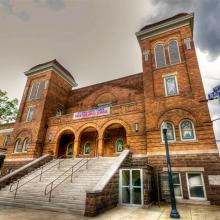american history

Indian River School Board member Peggy Jones speaks during a town hall meeting in Gifford at the Gifford Community Center, July 31, 2023. Jones asks while holding back tears, "Can you imagine an African American middle school student sitting in a classroom and seeing there is a benefit of slavery? Can you imagine an African American teacher having to teach that?" Credit: USA TODAY NETWORK via Reuters Connect.
Across the U.S., a coordinated effort is being made to suppress any history that might be deemed “uncomfortable” to its listeners.
In Oklahoma, the state’s superintendent of public instruction Ryan Walters sparked outrage by saying that teachers could teach about the Tulsa Race Massacre so long as they did not, “tie it to the skin color and say that the skin color determined it.” New legislation restricting the teaching of “divisive concepts” in Tennessee, Georgia, and New Hampshire has teachers fearing they’ll be fired simply for discussing racism or sexism in history.
KELLY BROWN DOUGLAS (The Black Christ) is known for widening the circle for disinherited people to identify with the Black Jesus of her mentor, James H. Cone. In Resurrection Hope, Douglas wrestles with how ongoing Black suffering challenges her faith, sparked by questions her adult son asks when yet another Black person is murdered by police or violently assaulted. “How long do we have to wait for the justice of God?” Douglas’ son asks. “I get it, that Christ is Black, but that doesn’t seem to be helping us right now.”
Her son’s visceral theodicy questions cause Douglas to wonder if her Christology of a Black Jesus who identifies with those experiencing “crucifying realities” is enough.
Douglas digs into history and details anti-Black narratives and white supremacy in the very architecture of Christian theology. She traces the development of what W.E.B. Du Bois called “the white gaze.” This white way of knowing “fosters death for Black bodies” by both overt means and the insidious silence of “good white people.”
More than usual this past week, I've needed small reminders about the possibility of justice. Why? Well, this week is the week of the 100th anniversary of the Tulsa Race Massacre.

Kim Kelley-Wagner Shrouded statue of Robert E. Lee in a Charlottesville park.
THERE IS NOTHING new under the sun, as the author of Ecclesiastes reminds us. In this, theologian Elsa Tamez said, we can “find solidarity in our discontent.”
I visited Charlottesville in May, nearly a year after the “summer of hate.” I heard from young Christians who had been on the frontlines at Robert E. Lee Park (now called Emancipation Park). I stood in the presence of their discontent, listening and witnessing to the ongoing, traumatizing effects of last summer’s “fascist lollapalooza,” as one University of Virginia professor put it.
Still reckoning with the memory of Aug. 12, one leader in his 20s shared how he had tried to be a nonviolent defender amid multiple “armed actors,” including the Ku Klux Klan, neo-Nazis, anti-fascists, and police. By the end of that day, two state troopers were dead, one woman was murdered, dozens were injured, and the whole community was emotionally, spiritually wounded.
AS A WHITE native Mississippian, I grew up among Confederate sympathizers. As an adopted Kentuckian, I live among them still. But the news cycles lately have been dominated by some fans of the Confederacy unlike any I’ve ever seen.
First there were the neo-Nazis in Charlottesville, who purported to defend the honor of Robert E. Lee by chanting slogans such as “Jews will not replace us!” Those twisted and deluded young men and women are ignorant of so much; how could they be expected to know about the thousands of Jewish Confederate soldiers, or the Confederacy’s Jewish attorney general?
Then came President Trump, a New Yorker, going all atwitter about the loss of the “beautiful” [Confederate] statues and monuments in “our cities, towns, and parks.” Closer to home, our Kentucky governor, Matt Bevin, a right-wing multimillionaire businessman who grew up in New Hampshire, accused Kentuckians who want to remove a statue of Jefferson Davis from our state capitol of a “sanitization of history.” (Bevin later denied he said this—though there is a recording—and asserted that he meant to call these efforts “revisionist.”)
Unlike Bevin, I’ve seen history “sanitized.”
In one of his last official acts, President Obama has designated Sixteenth Street Baptist Church, and other civil rights landmarks in Birmingham, Ala., as the Birmingham Civil Rights National Monument.
The designation protects the historic A.G. Gaston Motel in that city, where the Rev. Martin Luther King Jr. and other civil rights leaders had their 1963 campaign headquarters, as well as Kelly Ingram Park, where police turned hoses and dogs on civil rights protesters. And it includes the Sixteenth Street Baptist Church, where four girls died in 1963, after the Ku Klux Klan detonated 19 sticks of dynamite outside the church basement.
"Islam Hates Us!"
The recurring headline screams across every kind of media. Fear-based stories about Muslims have become standard fare this election cycle, rooted in the notion that Muslims are recent arrivals in America and somehow don’t belong. Some go so far as to suggest Muslims need to be plucked out from American society and “sent back home.”

Pope Francis leads the Easter vigil mass in Saint Peter's Basilica on Holy Saturday. Vatican City, 19 April 2014. Photo via giulio napolitano / Shutterstock.com
Yes, popes have been visiting the U.S. since Paul VI spent a day in New York in 1965, and each of the following eight papal trips — seven by John Paul II and one by Pope Emeritus Benedict XVI — has been widely anticipated, and enormously successful.
Is it far-fetched to think this could be any different this time — that images of a beaming Roman pontiff taking in the local flavor would not lead to a surge of warm feelings toward a Catholic Church otherwise regarded as beleaguered and out-of-touch?
Yet at a moment of such excitement and goodwill, it is important to remember how unusual this trip is in the context of American history: The idea that a pope could arrive in the United States to fanfare and adulation, especially from leading American politicians, was once unthinkable.
Consider the case of Archbishop Gaetano Bedini, a representative of Pope Pius IX whose 1853 U.S. tour wrought an assassination plot and sparked violence in Cincinnati streets that led to one protester’s death and forced Bedini to flee the country under cover of night. Such extreme reactions grew from Bedini’s close association with his imperious boss, the pope, who denounced democratic government, religious liberty and all of “modern civilization.”
Sunday, February 19, marked the 70th anniversary of the Japanese Internment Camps. In honor of the many Japanese Americans affected, the Japanese American National Museum partnered with Ancestry.com to start the Remembrance Project to ensure these Americans were not forgotten.
It’s important for Americans to remember this part of their history, George Takei tells The Washington Post.
I’m astounded by the number of people — particularly east of the Rockies — who say to me, aghast, ‘I had no idea such a thing had happened in the United States.’
During a roundtable chat with a group of emerging young evangelical leaders recently, someone posed the question: “Has America become a post racial society?”
Well, we haven’t had a race riot in a while — does that mean race isn’t relevant anymore?
A black president just gave the State of the Union Address. How about that? Does that mean America’s OK with the race thing?
Our nation is a more ethnically diverse nation than it’s ever been. Does that count for anything?
Scholars across disciplines agree that what we think of as “race” literally was invented here in the 17th century to delineate castes within a system of extreme privilege and subjugation.
So, rather than thinking about the dreaded word, “racism,” to answer the question, perhaps it would be more helpful to think about how our society has been “racialized” and then ask if such a racialization still exists or reverberates in today's American culture.
At the climax of The King's Speech, I held my breath with the rest of the packed audience and hoped to God that history was kind to King George VI.





